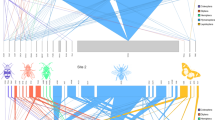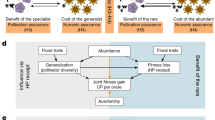Abstract
Both exotic and native plant species rely on insect pollinators for reproductive success, and yet few studies have evaluated whether and how exotic plant species receive services from native pollinators for successful reproduction in their introduced range. Plant species are expected to successfully reproduce in their exotic range if they have low reliance on animal pollinators or if they successfully integrate themselves into resident plant–pollinator networks. Here, we quantify the breeding system, network integration, and pollen limitation for ten focal exotic plant species in North America. Most exotic plant species relied on animal pollinators for reproduction, and these species varied in their network integration. However, plant reproduction was limited by pollen receipt for only one plant species. Our results demonstrate that even poorly integrated exotic plant species can still have high pollination service and high reproductive success. The comprehensive framework considered here provides a method to consider the contribution of plant breeding systems and the pollinator community to pollen limitation, and can be applied to future studies to provide a more synthetic understanding of the factors that determine reproductive success of exotic plant species.

Similar content being viewed by others
References
Arduser M (2011) Key to bee genera in Missouri
Baker HG (1955) Self-compatibility and establishment after “long-distance” dispersal. Evolution 9:347
Barrett SCH, Harder LD, Worley AC (1996) The comparative biology of pollination and mating in flowering plants. Philos Trans R Soc Lond Ser B 351:1271–1280
Bartomeus I, Vilà M, Santamaría L (2008) Contrasting effects of invasive plants in plant–pollinator networks. Oecologia 155:761–770
Bicknell RA, Koltunow AM (2004) Understanding apomixis: recent advances and remaining conundrums. Plant Cell 16:S228–S245
Burns JH, Ashman TL, Steets JA, Harmon-Threatt A, Knight TM (2011) A phylogenetically controlled analysis of the roles of reproductive traits in plant invasions. Oecologia 166:1009–1017
Cheptou PO, Massol F (2009) Pollination fluctuations drive evolutionary syndromes linking dispersal and mating system. Am Nat 174:46–55
Colwell RK, Coddington JA (1994) Estimating terrestrial biodiversity through extrapolation. Philos Trans R Soc Lond Ser B 345:101–118
Daehler CC (1998) The taxonomic distribution of invasive angiosperm plants: ecological insights and comparison to agricultural weeds. Biol Conserv 84:167–180
Deering RH, Vankat JL (1999) Forest colonization and developmental growth of the invasive shrub Lonicera maackii. Am Midl Nat 141:43–50
Donnelly SE, Lortie CJ, Aarssen LW (1998) Pollination in Verbascum thapsus (Scrophulariaceae): the advantage of being tall. Am J Bot 85:1618–1625
Dornier A, Munoz F, Cheptou PO (2008) Allee effect and self-fertilization in hermaphrodites: reproductive assurance in a structured metapopulation. Evolution 62:2558–2569
Eaton ER, Kaufman K (2007) Kaufman field guide to insects of North America. Houghton Mifflin Harcourt, New York
Goodell K, McKinney AM, Lin CH (2010) Pollen limitation and local habitat-dependent pollinator interactions in the invasive shrub Lonicera maackii. Int J Plant Sci 171:63–72
Gupta SK, Hamal IA, Koul AK (1985) Reproductive biology of Torilis arvensis (Hudson) Link. Proc Indian Acad Sci (Plant Sci) 95:227–236
Harmon-Threatt AN, Burns JB, Shemyakina LA, Knight TM (2009) Breeding system and pollination ecology of introduced plants compared to their native relatives. Am J Bot 96:1544–1550
Herron-Sweet CR, Lehnhoff EA, Burkle LA, Littlefield JL, Mangold JM (2016) Temporal- and density-dependent impacts of an invasive plant on pollinators and pollination services to a native plant. Ecosphere 7:1–13
Holm H (2014) Pollinators of native plants: attract, observe and identify pollinators and beneficial insects with native plants. Pollination Press LLC, Minnetonka
Kleijn D, Winfree R, Bartomeus I, Carvalheiro LG, Henry M, Isaacs R, Klein AM, Kremen C, M’Gonigle LK, Rader R, Ricketts TH, Williams NM, Adamson NL, Ascher JS, Báldi A, Batáry P, Benjamin F, Biesmeijer JC, Blitzer EJ, Bommarco R, Brand MR, Bretagnolle V, Button L, Cariveau DP, Chifflet R, Colville JF, Danforth BN, Elle E, Garratt MPD, Herzog F, Holzschuh A, Howlett BG, Jauker F, Jha S, Knop E, Krewenka KM, Le Féon V, Mandelik Y, May EA, Park MG, Pisanty G, Reemer M, Riedinger V, Rollin O, Rundlöf M, Sardiñas HS, Scheper J, Sciligo AR, Smith HG, Steffan-Dewenter I, Thorp R, Tscharntke T, Verhulst J, Viana BF, Vaissière BE, Veldtman R, Ward KL, Westphal C, Potts SG (2015) Delivery of crop pollination services is an insufficient argument for wild pollinator conservation. Nat Commun 6:7414
Knight TM, Steets JA, Vamosi JC, Mazer SJ, Burd M, Campbell DR, Dudash MR, Johnston MO, Mitchell RJ, Ashman TL (2005) Pollen limitation of plant reproduction: pattern and process. Annu Rev Ecol Syst 36:467–497
Knight TM, Steets JA, Ashman TL (2006) A quantitative synthesis of pollen supplementation experiments highlights the contribution of resource reallocation to estimates of pollen limitation. Am J Bot 93:271–277
McIver J, Erickson K (2012) Pollination biology of Potentilla recta (Sulfur Cinquefoil) and its cooccurring native congener Potentilla gracilis in northeastern Oregon. Psyche 2012:1–18
Memmott J, Waser NM (2002) Integration of alien plants into a native flower-pollinator visitation web. Proc R Soc Lond 269:2395–2399
MO (2017) Missouri botanical garden online herbarium. http://www.tropicos.org/. Accessed 27 Aug 2017
Montero-Castaño A, Vilà M (2017) Influence of the honeybee and trait similarity on the effect of a non-native plant on pollination and network rewiring. Funct Ecol 31:142–152
Moodley D, Geerts S, Richardson DM, Wilson JRU (2016) The importance of pollinators and autonomous self-fertilisation in the early stages of plant invasions: Banksia and Hakea (Proteaceae) as case studies. Plant Biol (Stuttg) 18:124–131
Morales CL, Aizen MA (2006) Invasive mutualisms and the structure of plant–pollinator interactions in the temperate forests of north-west Patagonia, Argentina. J Ecol 94:171–180
Morales CL, Traveset A (2009) A meta-analysis of impacts of alien vs. native plants on pollinator visitation and reproductive success of co-flowering native plants. Ecol Lett 12:716–728
Naumova TN (1992) Apomixis in angiosperms: nucellar and integumentary embryony angiosperms. CRC Press, Boca Raton, Florida
Oksanen J, Blanchet FG, Friendly M, Kindt R, Legendre R, McGlinn D, Minchin PR, O’Hara RB, Simpson GL, Solymos P, Stevens MHH, Szoecs E, Wagner H (2016) vegan: Community Ecology Package (R package version 2.4-0). https://cran.r-project.org/packages=vegan
Ollerton J, Winfree R, Tarrant S (2011) How many flowering plants are pollinated by animals? Oikos 120:321–326
Pannell JR, Barrett SCH (1998) Baker’s law revisited: reproductive assurance in a metapopulation. Evolution 52:657
Pearse WD, Cadotte MW, Cavender-Bares J, Ives AR, Tucker CM, Walker SC, Helmus MR (2015) pez: phylogenetics for the environmental sciences (R package version 1.1-1). Bioinformatics 31:2888–2890
Razanajatovo M, van Kleunen M (2016) Non-invasive naturalized alien plants were not more pollen-limited than invasive aliens and natives in a common garden. Funct Ecol 30:1511–1520
Richardson DM, Allsopp N, D’antonio CM, Milton SJ, Rejmanek M (2000) Plant Invasions—the role of mutualisms. Biol Rev Camb Philos Soc 75:65–93
RStudio Team (2015) RStudio: integrated development for R. RStudio Inc, Boston
Stouffer DB, Cirtwill AR, Bascompte J (2014) How exotic plants integrate into pollination networks. J Ecol 102:1442–1450
Sutton AJ, Abrams KR, Jones DR, Sheldon TA, Song F (2000) Methods for meta-analysis in medical research, vol 1. Wiley, New York
Thompson SG (1998) Meta-analysis, vol 4. Encyclopedia of biostatistics. Wiley, New York, pp 2570–2579
van Kleunen M, Johnson SD (2007) Effects of self-compatibility on the distribution range of invasive european plants in north America. Conserv Biol 21:1537–1544
van Kleunen M, Manning JC, Pasqualetto V, Johnson SD (2008) Phylogenetically independent associations between autonomous self-fertilization and plant invasiveness. Am Nat 171:195–201
Vilà M, Bartomeus I, Dietzsch AC, Petanidou T, Steffan-Dewenter I, Stout JC, Tscheulin T (2009) Invasive plant integration into native plant–pollinator networks across Europe. Proc R Soc Lond 276:3887–3893
Ward M, Johnson SD, Zalucki MP (2012) Modes of reproduction in three invasive milkweeds are consistent with Baker’s rule. Biol Invasions 14:1237–1250
Winfree R, Fox JW, Williams NM, Reilly JR, Cariveau DP (2015) Abundance of common species, not species richness, drives delivery of a real-world ecosystem service. Ecol Lett 18:626–635
Woods TM, Hartnett DC, Ferguson CJ (2009) High propagule production and reproductive fitness homeostasis contribute to the invasiveness of Lespedeza cuneata (Fabaceae). Biol Invasions 11:1913–1927
Zanne AE, Tank DC, Cornwell WK, Eastman JM, Smith SA, FitzJohn RG, McGlinn DJ, O’Meara BC, Moles AT, Reich PB, Royer DL, Soltis DE, Stevens PF, Westoby M, Wright IJ, Aarssen L, Bertin RI, Calaminus A, Govaerts R, Hemmings F, Leishman MR, Oleksyn J, Soltis PS, Swenson NG, Warman L, Beaulieu JM (2015) Zanne et al. reply. Nature 521:E6–E7
Zimmerman M, Pyke GH (1988) Reproduction in polemonium: assessing the factors limiting seed set. Am Nat 131:723–738
Acknowledgements
We would like to thank Valentin Ștefan for his help preparing the figures; Sam Levin, Brenda Alvarado, and the invasive plant team at Tyson in helping collect the field data; Mike Arduser, James Trager, Tad Yankoski, and Chris Hartley in helping identify pollinators. This manuscript was improved by useful suggestions from members of Knight’s spatial interaction ecology research group, Associate Editor Feng, and one anonymous reviewer.
Funding
This study was funded by the National Science Foundation Division of Environmental Biology (DEB 1145274) and by the Alexander von Humboldt Foundation in the framework of the Alexander von Humboldt Professorship of TM Knight endowed by the German Federal Ministry of Education and Research.
Author information
Authors and Affiliations
Contributions
AHT and TMK conceived and designed the experiments. AHT performed the experiments under guidance from TMK. AHT and TMK analyzed the data and wrote the manuscript.
Corresponding author
Ethics declarations
Conflict of interest
The authors declare that they have no conflict of interest.
Ethical approval
This article does not contain any studies with human participants or animals performed by any of the authors.
Additional information
Communicated by Yu-Long Feng.
Electronic supplementary material
Below is the link to the electronic supplementary material.
Rights and permissions
About this article
Cite this article
Thompson, A.H., Knight, T.M. Exotic plant species receive adequate pollinator service despite variable integration into plant–pollinator networks. Oecologia 187, 135–142 (2018). https://doi.org/10.1007/s00442-018-4096-4
Received:
Accepted:
Published:
Issue Date:
DOI: https://doi.org/10.1007/s00442-018-4096-4




